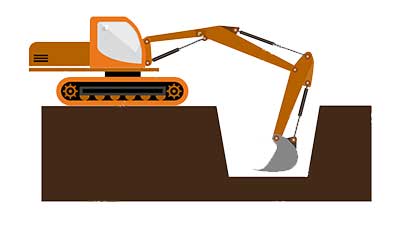Title Page
-
Client / Site
-
Job #
-
Project Name
-
Project Location
-
Conducted on
-
Prepared by
Excavation Information
-
Excavation project description
-
Is there any confined spaces entry into pipes manholes? if so complete confined space Audit questions.
-
Can a restricted space entry be made?
-
Excavation Depth
-
Excavation Width
-
Excavation length
-
Take photo of the excavation area
-
Is trench notifiable to WorkSafe? > than 1.5 M
-
Excavation plant and machines used Digger/plate compacters/
-
Has all heavy equipment undergone safety checks?
-
Is digger being used for lifting pipes?
-
is there a visible exclusion zone in place ie cones hockey sticks tape?
-
Does digger have SWL displayed on the dipper arm?
-
Is the lifting eye certified and marked?
-
Has a lift plan been implemented for the day?
-
Is a load chart visible in machine?
-
Are there drop (anti-Burst Valves) fitted to digger?
-
Is the operator licensed trained and assessed to sling lift move loads by unit standard 30072?
-
Area all lifting chains and strops tagged?
-
Is the spotter/dogman formally trained
-
Weather
- Rainy
- Stormy
- Cloudy
- Sunny
- Hot
- Dry
- Wet
- Foggy
- Snow
-
Soil Type
- Stable rock
- Type A
- Type B
- Type C
-
Protective System
-
Enter other protective system type.
-
Is benching or sloping in accordance with WorkSafe guidelines?
-
Is the trench shield certified by a registered Engineer?
-
Is the shield correctly installed refer to WorkSafe COP?
-
Are trenches edges safe is there a method of preventing persons to fall into the trench?
Jobsite Inspection
-
Is there a competent person on site who has the authority to inspect trench stability and make calls as to removing workers from an excavation if required?
-
Excavations, adjacent areas, and protective systems inspected by a competent person daily before the start of work.
-
Surface obstacles or burdens removed or supported.
-
Spoils, materials, and equipment set back at least 500mm from the edge of the excavation.
-
Barriers provided at all remotely located excavations, wells, pits, shafts, etc.
-
Walkways and bridges over excavations 1.5 m or more in depth are equipped with standard guardrails and toeboards.
-
Warning system established and utilized when mobile equipment is operating near the edge of the excavation.
-
Employees protected from loose rock or soil that could pose a hazard by falling or rolling into the excavation.
-
Employees required to stand away from vehicles being loaded or unloaded.
-
Employees prohibited from going under suspended loads.
-
Employees prohibited from working on the faces of slopes or benched excavations above other employees.
-
Hard hats worn by all employees.
-
Hi Vis vests visible provided and worn by all employees on site.
Utilities
-
Utility companies contacted and/or utilities located.
-
Exact location of utilities marked.
-
Underground installations protected, supported, or removed when excavation is open.
Entry and Exit
-
Lateral travel to means of egress no greater than 6 metres in excavations 1.5 m or more in depth.
-
Ladders used in excavations secured and extended three rungs above the edge of the trench.
-
Structural ramps used by employees designed by a competent person.
-
Structural ramps used for equipment designed by a registered professional engineer (RPE)
-
Ramps constructed of materials of uniform thickness, cleated together on the bottom, equipped with no-slip surface.
-
Employees protected from cave-ins when entering or exiting the excavation.
Wet Conditions
-
Precautions take to protect employees from the accumulation of water.
-
Water removal equipment monitored by a competent person.
-
Surface water or runoff diverted or controlled to prevent accumulation in the excavation.
-
Inspections made after every rainstorm or other hazard-increasing occurrence.
Hazardous Atmosphere
-
Atmosphere within the excavation tested where there is a reasonable possibility of an oxygen deficiency, combustible or other harmful contaminant exposing employees to a hazard.
-
Adequate precautions taken to protect employees from exposure to an atmosphere containing less than 19.5% oxygen and/or to other hazardous atmospheres
-
Ventilation provided to prevent employee exposure to an atmosphere containing flammable gas in excess of 10% of the lower explosive limit of the gas.
-
Testing conducted often to ensure that the atmosphere remains safe.
-
Emergency equipment, such as breathing apparatus, safety harness and lifeline, and/or basket stretcher readily available where hazardous atmospheres could or do exist.
-
Employees trained to use personal protective and other rescue equipment.
-
Safety harness and lifeline used and individually attended when entering bell bottom or other deep confined excavations
Support Systems
-
Are extension and power boards commercially rated?
-
Are leads and plugs in good condition no exposed wires
-
Are all powered appliances and equipment protect through RCD and monitored earthing circuits?
-
Materials and/or equipment for support systems selected based on soil analysis, trench depth, and expected loads.
-
Materials and equipment used for protective systems inspected and in good condition.
-
Materials and equipment not in good condition have been removed from service.
-
Damaged materials and equipment used for protective systems inspected by a registered professional engineer (RPE) after repairs and before being placed back into service.
-
Protective systems installed without exposing employees to the hazards of cave-ins, collapses, or threat of being struck by materials or equipment.
-
Members of support system securely fastened to prevent failure.
-
Support systems provided in ensure stability of adjacent structures, buildings, roadways, sidewalks, walls, etc.
-
Excavations below the level of the base or footing supported, approved by an RPE.
-
Removal of support systems progresses from the bottom and members are released slowly as to note any indication of possible failure.
-
Backfilling progresses with removal of support system.
-
Excavation of material to a level no greater than 500mm below the bottom of the support system and only if the system is designed to support the loads calculated for the full depth.
-
Shield system placed to prevent lateral movement.
Recommendations
-
Enter recommendations here
Completion
-
Full Name and Signature of Auditor










